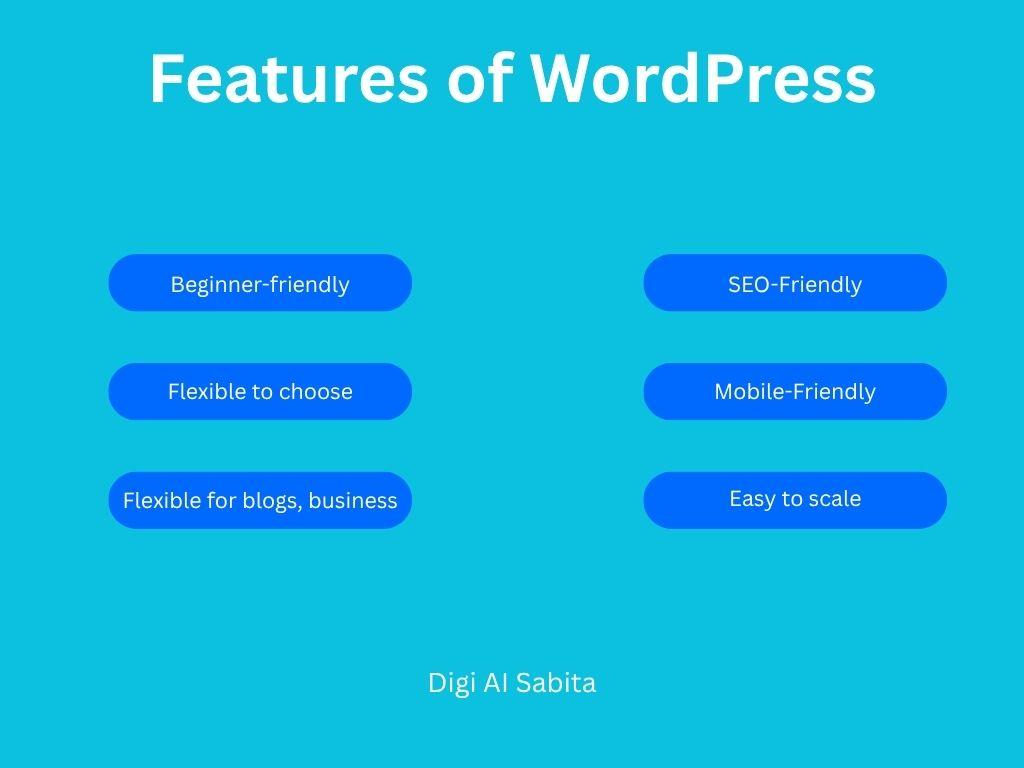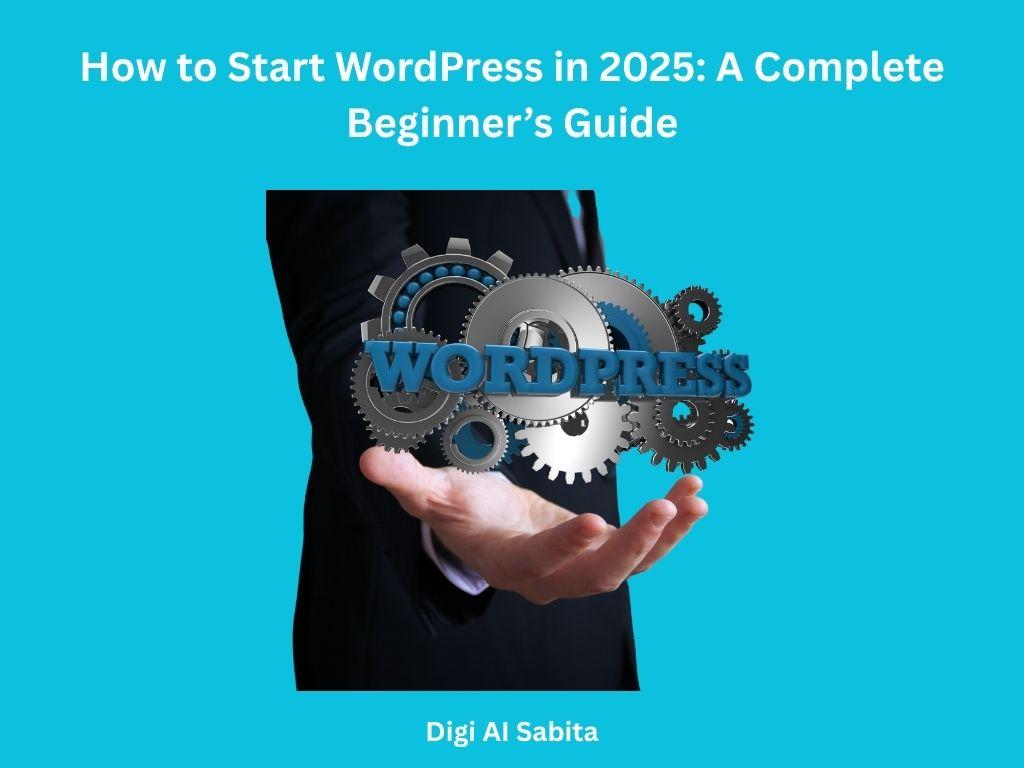Introduction: WordPress in 2025
Starting your journey with WordPress in 2025 is one of the most intelligent decisions you can make to establish your online presence. Whether you’re starting a blog, portfolio, business website, or e-commerce platform, WordPress is still the most widely used and flexible platform for creating a website. It is simple and easy to use.
In this complete beginner’s guide, you’ll learn how to set up your WordPress website step by step, from domain registration to design and launching your first post.
- Features of WordPress
- How to Start WordPress in 2025:
- Step 1: Choose a Domain Name and Hosting Provider
- Step 2: Install WordPress
- Step 3: Set Up Basic Settings
- Step 4: Select and Install a Theme
- Step 5: Install Essential Plugins
- Step 6: Create Essential Pages
- Step 7: Personalize Your Navigation Menu
- Step 8: Publish Your First Blog Post
- Step 9: Speed Up and SEO Optimize Your Site
- Step 10: Ensure Your Site is Secure and Up-to-Date
- Bonus WordPress Tips for Success in 2025
- Why WordPress in 2025?
- What Can You Build with WordPress?
- Conclusion
- You may like:
Features of WordPress

The main features of WordPress are:
- It is beginner-friendly because it is easy and simple to use dashboard and visual editor.
- Flexible to choose from a broad range of free and paid themes and plugins.
- Flexible for blogs, business sites, portfolios, e-commerce sites, and others.
- SEO-Friendly for search engine optimization right out of the box, with plugins such as Rank Math or Yoast SEO to further increase visibility.
- Most themes are mobile responsive.
- Easy to scale, perfect for small personal blogs or enterprise-level websites.
How to Start WordPress in 2025:
In this guide, we’ll focus on the self-hosted WordPress.org version — the more powerful and flexible option.
Step 1: Choose a Domain Name and Hosting Provider
Domain Name
Your domain name is your website’s address (e.g., www.yourwebsite.com). Pick something short, memorable, and relevant to your brand or niche.
Tips:
- Use keywords if possible
- Avoid hyphens and numbers
- Choose a suitable extension (e.g., .com, .net, .online)
Web Hosting
A hosting company keeps your website files and makes them available online.
In 2025, some of the best hosting choices optimized for WordPress are:
• Bluehost (beginner-friendly, officially endorsed by WordPress)
• SiteGround (fast and secure)
• Hostinger (budget-friendly plans)
• WP Engine (high-end managed WordPress hosting)
What to look for:
• 1-click WordPress installation
• Free SSL certificate
• Good uptime and speed
• Customer support
Step 2: Install WordPress
Most hosting companies provide 1-click WordPress installation. Here’s how it usually works:
1. Log into your hosting dashboard (e.g., cPanel)
2. Locate the WordPress installer (Softaculous or equivalent)
3. Select your domain and click Install
4. Define your site title, admin username, and password
5. Finish installation and log into your WordPress dashboard (yourdomain.com/wp-admin)
Well done, your site is live!
Step 3: Set Up Basic Settings
After logging in, change the basic settings from the WordPress dashboard:
1. Go to Settings > General
- Set your Site Title and Tagline
- Verify the WordPress Address and Site Address (should be identical)
- Set time zone and language
2. Navigate to Settings > Permalinks
Select the “Post name” option for clean, SEO-perfect URLs (e.g., yourdomain.com/sample-post/)
3. Enable SSL (if not automatically enabled)
- Find “Let’s Encrypt” SSL in your hosting control panel
- Redirect to HTTPS in WordPress settings or through plugin such as Really Simple SSL
Step 4: Select and Install a Theme
A theme determines the look of your website.
Free Themes:
Go to Appearance- Themes- Add New to explore and install free themes from the WordPress repository.
Well-known beginner-friendly themes in 2025:
- Astra- fast, customizable
- GeneratePress- lightweight and clean
- Neve- modern and mobile-first
- Blocksy- ideal for block-based designs
Premium Themes
Explore platforms such as:
- ThemeForest
- StudioPress
- Kadence
Premium themes typically provide enhanced support, features, and design options.
Customize Your Theme
After installing a theme:
- Go to Appearance > Customize
- Change your logo, colors, fonts, and layout
• Add site identity, homepage settings, and menus
Step 5: Install Essential Plugins
Plugins add functionality to your site. Here are essential plugins in 2025:
Purpose- Recommended Plugin
SEO- Rank Math, Yoast SEO
Security- Wordfence, Sucurity
Backups- UpdraftPlus
Speed- WP Rocket, LiteSpeed Cache
Forms- WPForms, Formidable
Page Builder- Elementor, Spectra
Analytics- Site Kit by Google
Anti-Spam- Akismet Anti-Spam
To install a plugin:
- Go to Plugins > Add New
- Search for plugin name
- Click Install Now and Activate
Step 6: Create Essential Pages
Begin with these important pages:
1. Home Page – Welcome your site and direct visitors
2. About Page – Tell your story and mission
3. Contact Page – Add form, email, map, or social links
4. Blog Page – Where your posts will be displayed
5. Privacy Policy & Terms – For legal purposes
Navigate to Pages: Add New, use the block editor or a page builder such as Elementor for simple design.
Step 7: Personalize Your Navigation Menu
To assist visitors in navigating:
1. Navigate to Appearance- Menus
2. Add new menu (e.g., “Main Menu”)
3. Add your pages, posts, or custom links
4. Determine the menu location (e.g., primary or header)
Tip: Use dropdowns for well-organized menus if you have more than one category or service.
Step 8: Publish Your First Blog Post
1. Go to Posts: Add New
2. Set your post title and content with the Gutenberg Block Editor
3. Add:
- Headings
- Images (optimize them for speed)
- Categories and tags
- Featured image
4. Preview your post and click Publish
Consistency is key, attempt to post on a regular basis and offer value to your readers.
Step 9: Speed Up and SEO Optimize Your Site
Speed Tips
- Utilize a light theme and plugins
- Optimize images (utilize WebP format and compression)
- Turn caching on (via WP Rocket or LiteSpeed)
- Utilize a CDN (such as Cloudflare)
SEO Basics
- Install Rank Math or Yoast SEO
- Include keywords in titles, meta descriptions, and URLs
- Write alt text for images
- Make internal links to other content
- Add your site to Google Search Console
Step 10: Ensure Your Site is Secure and Up-to-Date
Security Best Practices
- Strong passwords
- Install a security plugin (Wordfence, e.g.)
- Update themes and plugins
- Regularly backup with UpdraftPlus
- Lock down login attempts and implement 2FA
Bonus WordPress Tips for Success in 2025
- Employ AI tools: Write quicker with ChatGPT or SEO tools like Surfer AI
- Be mobile-first: The majority of traffic is mobile — use responsive themes
- Learn basic design: Tools like Canva help create great visuals
- Engage your audience: Add social sharing, comments, and newsletters
- Monetize your site: Add affiliate links, ads, or sell products/services
Why WordPress in 2025?
- Ease of use: User-friendly dashboard and editor
- Customization: Thousands of themes and plugins
- Scalability: From small blogs to corporate websites
- SEO-friendly: In-built and plugin-based SEO functionalities
- Community Support: An enormous ecosystem of developers, forums, and tutorials
What Can You Build with WordPress?
So many activities can be done through WordPress for earning passive income. Such as:
- Blogs
- Business sites
- Portfolios
- Online shops (through WooCommerce)
- Membership sites
- Online courses
- News or magazine websites
Conclusion
Starting WordPress in 2025 is easier than every, and incredibly rewarding. With the right tools, a clear plan, and this step-by-step guide, you’re well on your way to launching a powerful, professional website.
No matter if you’re creating a blog, business website, or e-commerce site, WordPress provides complete control and flexibility. Make the move today, your online journey begins here
